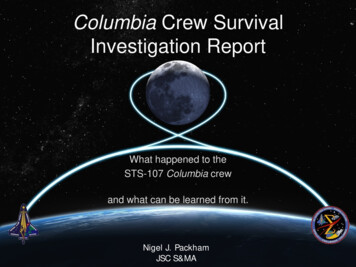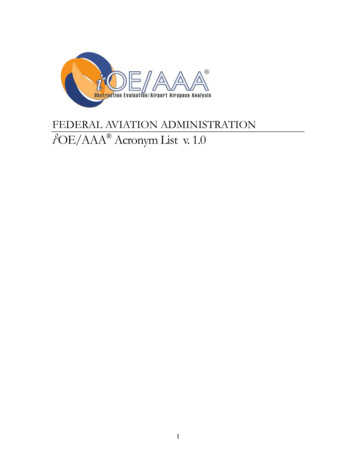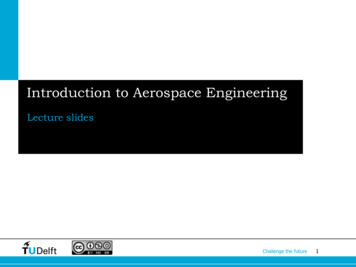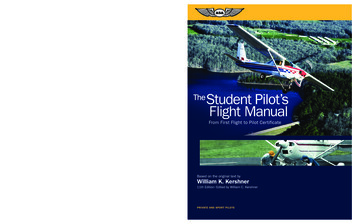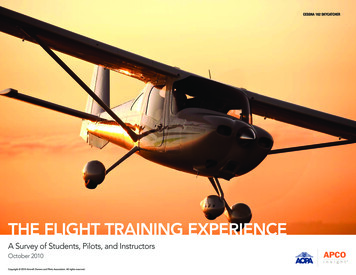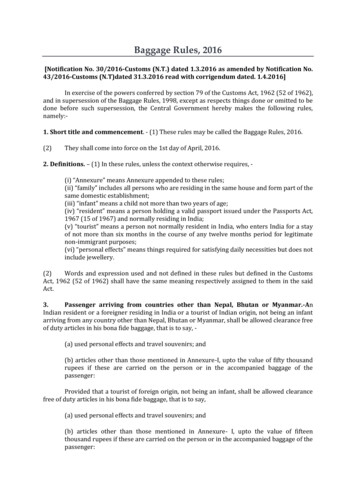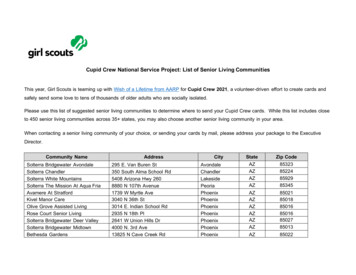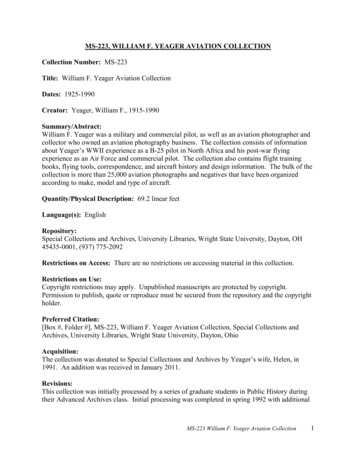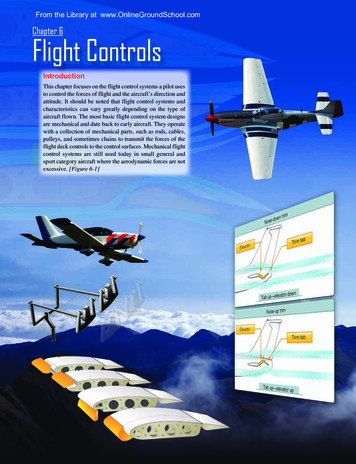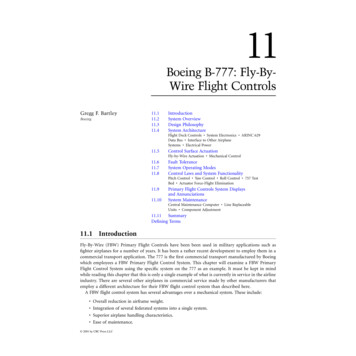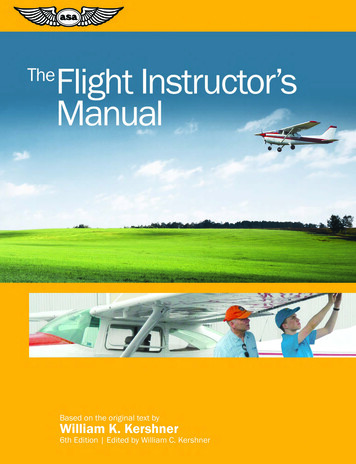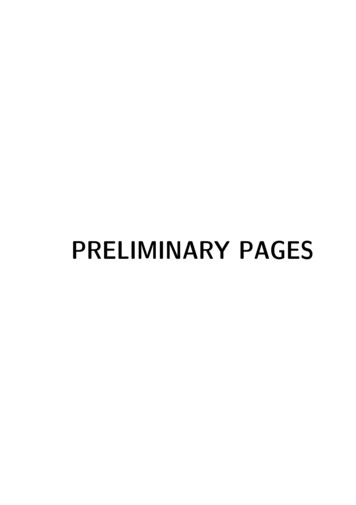
Transcription
PRELIMINARY PAGES
Intentionally left blank
PRELIMINARY PAGESA318/A319/A320/A321FLIGHT CREW TRAININGMANUALTABLE OF CONTENTSPLP. PRELIMINARY PAGESTABLE OF CONTENTS . 1/2LIST OF EFFECTIVE SECTIONS/SUBSECTIONS . 1/2LIST OF EFFECTIVE OPERATIONS ENGINEERING BULLETINS . 1/2LIST OF EFFECTIVE FLIGHT CREW TRAINING BULLETINS . 1/2AIRCRAFT ALLOCATION TABLE . 1/2LIST OF MODIFICATIONS . 1/2IN. IntroductionOP. Operational PhilosophyNO. Normal OperationsAO. Abnormal OperationsSI. Supplementary InformationPIR. Preventing Identified RisksFCA A318/A319/A320/A321 FLEETFCTMPLP-TOC. P 1/208 JUL 08
PRELIMINARY PAGESA318/A319/A320/A321TABLE OF CONTENTSFLIGHT CREW TRAININGMANUALIntentionally left blankFCA A318/A319/A320/A321 FLEETFCTMPLP-TOC. P 2/208 JUL 08
PRELIMINARY PAGESA318/A319/A320/A321LIST OF EFFECTIVE SECTIONS/SUBSECTIONSFLIGHT CREW TRAININGMANUALMPagesRev. DateIN-010LocalizationGENERAL INTRODUCTIONSubsection Title1/2 to 2/208 JUL 08OP-010INTRODUCTION1/2 to 2/208 JUL 08OP-020FLIGHT CONTROLS1/16 to 16/1608 JUL 08OP-030AP / FD / ATHR1/18 to 18/1808 JUL 08OP-040ECAM1/10 to 10/1008 JUL 08NO-010GENERAL1/4 to 4/408 JUL 08NO-020PRE START1/20 to 20/2008 JUL 08NO-030START1/4 to 4/408 JUL 08NO-040TAXI1/10 to 10/1008 JUL 08NO-050TAKEOFF1/10 to 10/1008 JUL 08NO-060CLIMB1/6 to 6/608 JUL 08NO-070CRUISE1/14 to 14/1408 JUL 08NO-080DESCENT1/8 to 8/808 JUL 08NO-090HOLDING1/2 to 2/208 JUL 08NO-100APPROACH GENERAL1/16 to 16/1608 JUL 08NO-110ILS APPROACH1/6 to 6/608 JUL 08NO-120NON PRECISION APPROACH1/10 to 10/1008 JUL 08NO-130CIRCLING APPROACH1/4 to 4/408 JUL 08NO-140VISUAL APPROACH1/4 to 4/408 JUL 08NO-150PRECISION APPROACH1/8 to 8/808 JUL 08NO-160LANDING1/12 to 12/1208 JUL 08NO-170GO AROUND1/6 to 6/608 JUL 08NO-180TAXI IN1/4 to 4/408 JUL 08AO-010GENERAL1/6 to 6/608 JUL 08AO-020OPERATING TECHNIQUES1/16 to 16/1608 JUL 08AO-022AUTOFLIGHT1/2 to 2/208 JUL 08AO-024ELECTRICAL1/2 to 2/208 JUL 08AO-026FIRE PROTECTION1/6 to 6/608 JUL 08AO-027FLIGHT CONTROLS1/2 to 2/208 JUL 08AO-028FUEL1/2 to 2/208 JUL 08AO-029HYDRAULIC1/4 to 4/408 JUL 08AO-032LANDING GEAR1/2 to 2/208 JUL 08AO-034NAVIGATION1/8 to 8/808 JUL 08AO-070POWER PLANT1/2 to 2/208 JUL 08AO-090MISCELLANEOUS1/6 to 6/608 JUL 08SI-010ADVERSE WEATHER1/16 to 16/1608 JUL 08FCA A318/A319/A320/A321 FLEETFCTMPLP-LESS. P 1/208 JUL 08
PRELIMINARY PAGESA318/A319/A320/A321LIST OF EFFECTIVE SECTIONS/SUBSECTIONSFLIGHT CREW TRAININGMANUALMPagesRev. DateSI-020LocalizationFLYING REFERENCESubsection Title1/4 to 4/408 JUL 08SI-030NAVIGATION ACCURACY1/8 to 8/808 JUL 08SI-0401/4 to 4/408 JUL 08SI-060ZFW - ZFCG ENTRY ERRORSZFW ZFCG ENTRY ERRORSTCAS1/4 to 4/408 JUL 08SI-070USE OF RADAR1/4 to 4/408 JUL 08PIR-010PREVENTING IDENTIFIED RISKS1/6 to 6/608 JUL 08FCA A318/A319/A320/A321 FLEETFCTMPLP-LESS. P 2/208 JUL 08
PRELIMINARY PAGESA318/A319/A320/A321FLIGHT CREW TRAININGMANUALMIdentificationLIST OF EFFECTIVE OPERATIONS ENGINEERING BULLETINT(1) E(2) Rev. DateTitle(1) Ecam Importance Type(2) Documentary Unit Impacted by EcamNo Operations Engineering BulletinFCA A318/A319/A320/A321 FLEETFCTMPLP-LEOEB. P 1/208 JUL 08
PRELIMINARY PAGESA318/A319/A320/A321FLIGHT CREW TRAININGMANUALLIST OF EFFECTIVE OPERATIONS ENGINEERING BULLETINIntentionally left blankFCA A318/A319/A320/A321 FLEETFCTMPLP-LEOEB. P 2/208 JUL 08
PRELIMINARY PAGESA318/A319/A320/A321FLIGHT CREW TRAININGMANUALMIdentificationLIST OF EFFECTIVE FLIGHT CREW TRAINING BULLETINRev. DateTitleNo Flight Crew Training BulletinFCA A318/A319/A320/A321 FLEETFCTMPLP-LEFCTB. P 1/208 JUL 08
PRELIMINARY PAGESA318/A319/A320/A321FLIGHT CREW TRAININGMANUALLIST OF EFFECTIVE FLIGHT CREW TRAINING BULLETINIntentionally left blankFCA A318/A319/A320/A321 FLEETFCTMPLP-LEFCTB. P 2/208 JUL 08
PRELIMINARY PAGESA318/A319/A320/A321AIRCRAFT ALLOCATION TABLEFLIGHT CREW TRAININGMANUALThis table gives, for each delivered aircraft, the cross reference between:- The Manufacturing Serial Number (MSN).- The Fleet Serial Number (FSN) of the aircraft as known by AIRBUSS.A.S.- The registration number of the aircraft as known by AIRBUS S.A.S.- The aircraft model.MMSN0781085213201637172017772180FSNFCA 0101FCA 0002FCA 0002FCA 0003FCA 0353FCA 0403FCA 0101FCA A318/A319/A320/A321 FLEETFCTMRegistration 14PLP-AAT. P 1/208 JUL 08
PRELIMINARY PAGESA318/A319/A320/A321AIRCRAFT ALLOCATION TABLEFLIGHT CREW TRAININGMANUALIntentionally left blankFCA A318/A319/A320/A321 FLEETFCTMPLP-AAT. P 2/208 JUL 08
PRELIMINARY PAGESA318/A319/A320/A321LIST OF MODIFICATIONSFLIGHT CREW TRAININGMANUALMMODIFICATIONLinked SBJ0071K2113K2962P2316P334132-1136 02P3379P3511P3560P3686P4089P431922-1058 42P4320FCA A318/A319/A320/A321 FLEETFCTMIncorp.DateTitle08 JUL 08 WINGS-WING TIP FENCES-INTRODUCE WINGTIPS INCLUDING FENCESApplicable to: ALL08 JUL 08 FUSELAGE - REAR FUSELAGE SECTION 16A DEFINE A321 BASIC STRUCTUREApplicable to: MSN 0781-0852, 172008 JUL 08 HYDRAULIC POWER-BLUE MAIN HYDRAULICPOWER-IMPROVE MAINTENANCE STATUS OFBLUE HYDRAULIC RESERVOIRApplicable to: MSN 1320-1637, 1777-218008 JUL 08 AUTO FLIGHT - ACTIVATE WINDSHEARFUNCTIONApplicable to: ALL08 JUL 08 LANDING GEAR - WHEELS AND BRAKES INSTALL MESSIER GOODRICH WHEELS ANDBRAKES ON A321Applicable to: MSN 0781-0852, 172008 JUL 08 INDICATING/RECORDING SYSTEMS GENERAL- DEFINE CPIP3Applicable to: ALL08 JUL 08 AUTO FLIGHT - FAC - INSTALL TWO FACSP/N BAM 0509Applicable to: ALL08 JUL 08 AUTO FLIGHT - FMGC - PROVIDE TIMECONSTRAINT AND TEN CHARACTERS RTEIDENT FUNCTIONSApplicable to: ALL08 JUL 08 AUTO FLIGHT-FAC-INTRODUCE FAC P/N BAM510Applicable to: ALL08 JUL 08 AUTO FLIGHT-FMGC-REDUCE VAPP FOR A320CFM/IAEApplicable to: MSN 1320-1637, 1777-218008 JUL 08 AUTO FLIGHT - FCU - DEFINE FLIGHTDIRECTOR ENGAGEMENT IN CROSSED BARSAT GO AROUNDApplicable to: MSN 0781, 1320-218008 JUL 08 AUTO FLIGHT-GENERAL-ACTIVATE GLOBALSPEED PROTECTION AND F/DDISENGAGEMENT UPON SPEEDCONSTRAINTSApplicable to: MSN 1320-2180PLP-LOM. P 1/208 JUL 08
PRELIMINARY PAGESA318/A319/A320/A321LIST OF MODIFICATIONSFLIGHT CREW TRAININGMANUALMMODIFICATIONLinked SBP5168P551832-1232 0132-1336 01P5768P605434-1186 05P6183P637532-1201 04P751922-1089 10P772132-1247 02P7790FCA A318/A319/A320/A321 FLEETFCTMIncorp.DateTitle08 JUL 08 NAVIGATION - MMR - INSTALL COLLINS MMRPROVIDING ILS AND GPS FUNCTIONApplicable to: MSN 1320-218008 JUL 08 LANDING GEAR-NORMAL BRAKINGINTRODUCE STD 8 BSCU (TWIN VERSION)Applicable to: ALL08 JUL 08 ELEC PWR-AC EMERGENCY GENERATIONACTIVATE A319/A321 ELECTRICALEMERGENCY CONFIGURATION ON A320 A/CApplicable to: MSN 1320-1637, 1777-218008 JUL 08 NAVIGATION - MMR - ACTIVATE GPSPRIMARY FUNCTION (HYBRID) IN SEXTANTMMR (WITH HONEYWELL OR LITTON ADIRU)Applicable to: ALL08 JUL 08 NAVIGATION - MMR - REMOVE COLLINS MMRPROVIDING ILS (FM IMMUNE) AND GPSPRIMARY FUNCTION (PREVIOUS SPEC.)Applicable to: MSN 1320-218008 JUL 08 LANDING GEAR-PARKING/ULTIMATEEMERGENCY BRAKING-INTRODUCE APRESSURE SWITCHApplicable to: MSN 0781-0852, 1637-218008 JUL 08 AUTOFLIGHT-FMGC-INSTALL FMGC CFMC13042AA01 (EQUIPPED WITH FMS2)HONEYWELLApplicable to: MSN 1320-218008 JUL 08 LANDING GEAR-WHEELS AND BRAKESCANCEL MIXABILITY BETWEEN GOODRICHBRAKES 2-1600-2 AND -3 AUTHOR. WITHMOD 31803Applicable to: MSN 1320-1637, 1777-218008 JUL 08 AUTO FLIGHT - FLIGHT MANAGEMENT ANDGUIDANCE SYSTEM - ACTIVATE FMAENHANCEMENT FUNCTIONApplicable to: MSN 2180PLP-LOM. P 2/208 JUL 08
INTRODUCTION
Intentionally left blank
INTRODUCTIONA318/A319/A320/A321FLIGHT CREW TRAININGMANUALPRELIMINARY PAGESTABLE OF CONTENTSIN-PLP. PRELIMINARY PAGESTABLE OF CONTENTS . 1/2IN-010. GENERAL INTRODUCTIONFOREWORD.1/2COMMENT - QUESTIONS - SUGGESTIONS .1/2FCA A318/A319/A320/A321 FLEETFCTMIN-PLP-TOC. P 1/208 JUL 08
INTRODUCTIONA318/A319/A320/A321PRELIMINARY PAGESFLIGHT CREW TRAININGMANUALTABLE OF CONTENTSIntentionally left blankFCA A318/A319/A320/A321 FLEETFCTMIN-PLP-TOC. P 2/208 JUL 08
INTRODUCTIONA318/A319/A320/A321FLIGHT CREW TRAININGMANUALGENERAL INTRODUCTIONFOREWORDIdent.: IN-010-00005422.0001001 / 12 MAR 08Applicable to: ALLThe Flight Crew Training Manual (FCTM) is published as a supplement to the FlightCrew Operating Manual (FCOM) and is designed to provide pilots with practicalinformation on how to operate the Airbus aircraft. It should be read in conjunction withthe FCOM. In the case of any conflict, the FCOM is the over-riding authority.Airline training policy may differ in certain areas. Should this be the case, the airlinetraining policy is the over-riding authority.COMMENT - QUESTIONS - SUGGESTIONSIdent.: IN-010-00005423.0001001 / 26 MAR 08Applicable to: ALLFCTM holders and users are encouraged to submit questions and suggestions regardingthis manual to:fltops.trainingdata@airbus.comorAIRBUS1, rond point Maurice BELLONTE31707 BLAGNAC CEDEX- FRANCEATTN: Flight Operations Support -- STLTFCA A318/A319/A320/A321 FLEETFCTMIN-010. P 1/208 JUL 08
INTRODUCTIONA318/A319/A320/A321GENERAL INTRODUCTIONFLIGHT CREW TRAININGMANUALIntentionally left blankFCA A318/A319/A320/A321 FLEETFCTMIN-010. P 2/208 JUL 08
OPERATIONALPHILOSOPHY
Intentionally left blank
OPERATIONAL PHILOSOPHYA318/A319/A320/A321FLIGHT CREW TRAININGMANUALPRELIMINARY PAGESTABLE OF CONTENTSOP-PLP. PRELIMINARY PAGESTABLE OF CONTENTS . 1/2OP-010. INTRODUCTIONINTRODUCTION.1/2OPERATIONAL GOLDEN RULES .1/2OP-020. FLIGHT CONTROLSINTRODUCTION. 1/16NORMAL LAW. 1/16ALTERNATE LAW . 5/16DIRECT LAW . 6/16INDICATIONS . 6/16PROTECTIONS. 7/16MECHANICAL BACKUP . 13/16ABNORMAL ATTITUDES. 14/16SIDESTICK AND TAKEOVER P/B . 15/16OP-030. AP / FD / ATHRAUTOPILOT/FLIGHT DIRECTOR . 1/18AUTOTHRUST (A/THR) . 4/18AP, FD, A/THR MODE CHANGES AND REVERSIONS . 10/18TRIPLE CLICK . 18/18OP-040. ECAMPURPOSE OF THE ECAM . 1/10MAIN principles . 1/10ECAM HANDLING . 2/10use of summaries. 8/10FCA A318/A319/A320/A321 FLEETFCTMOP-PLP-TOC. P 1/208 JUL 08
OPERATIONAL PHILOSOPHYA318/A319/A320/A321PRELIMINARY PAGESFLIGHT CREW TRAININGMANUALTABLE OF CONTENTSIntentionally left blankFCA A318/A319/A320/A321 FLEETFCTMOP-PLP-TOC. P 2/208 JUL 08
OPERATIONAL PHILOSOPHYA318/A319/A320/A321INTRODUCTIONFLIGHT CREW TRAININGMANUALINTRODUCTIONIdent.: OP-010-00005425.0001001 / 26 MAR 08Applicable to: ALLThe Airbus cockpit is designed to achieve pilot operational needs throughout the aircraftoperating environment, while ensuring maximum commonality within the Fly by Wirefamily.The cockpit design objectives are driven by three criteria: Reinforce the safety of flight Improve efficiency of flight Answer pilot requirements in a continuously changing environmentAirbus operational rules result from the design concept, more particularly from thefollowing systems: The Fly by wire system with its control laws and protections, commanded through theside stick, An integrated Auto Flight System (AFS) comprising:- The FMS interfaced through the MCDU,- The AP/FD interfaced through the FCU,- The A/THR interfaced through the non back driven thrust levers,- The FMA, providing Guidance targets and Information, to monitor the AFS A set of Display units (DU) providing information and parameters required by the crew- To operate and to navigate the aircraft (the EFIS)- To communicate (the DCDU)- To manage the aircraft systems (the ECAM)- FMA interface to provide Guidance targets and information to monitor the AFS/FD A Forward Facing Cockpit Layout with ”Lights out” or ”Dark Cockpit” conceptassisting the crew to properly control the various aircraft systems.The operational rules applicable to these specific features are given in the other sectionsof this chapter.OPERATIONAL GOLDEN RULESIdent.: OP-010-00005426.0001001 / 26 MAR 08Applicable to: ALL1. The aircraft can be flown like any other aircraft2. Fly, navigate, communicate - in that order3. One head up at all timesFCA A318/A319/A320/A321 FLEETFCTMOP-010. P 1/208 JUL 08
OPERATIONAL PHILOSOPHYA318/A319/A320/A321FLIGHT CREW TRAININGMANUALINTRODUCTION4. Cross check the accuracy of the FMS5. Know your FMA at all times6. When things don’t go as expected - take over7. Use the proper level of automation for the task8. Practice task sharing and back-up each otherFCA A318/A319/A320/A321 FLEETFCTMOP-010. P 2/208 JUL 08
OPERATIONAL PHILOSOPHYA318/A319/A320/A321FLIGHT CREW TRAININGMANUALFLIGHT CONTROLSINTRODUCTIONIdent.: OP-020-00005427.0001001 / 26 MAR 08Applicable to: ALLThe relationship between the Pilot Flying’s (PF’s) input on the sidestick, and theaircraft’s response, is referred to as control law. This relationship determines thehandling characteristics of the aircraft.There are three sets of control laws, and they are provided according to the status ofthe: Computers, peripherals, and hydraulic generation.The three sets of control laws are: Normal law Alternate law Direct law.NORMAL LAWIdent.: OP-020-00005428.0001001 / 29 MAY 08Applicable to: ALLOBJECTIVESThe aim of normal law is to provide the following handling characteristics within thenormal flight envelope (regardless of aircraft speed, altitude, gross weight and CG): Aircraft must be stable and maneuverable The same response must be consistently obtained from the aircraft The Actions on the sidestick must be balanced in pitch and in roll.The normal law handling characteristics, at the flight envelope limit are: The PF has full authority to achieve Maximum aircraft Performance The PF can have instinctive/immediate reaction, in the event of an emergency There is a reduced possibility of overcontrolling or overstressing the aircraft.Normal Law is the law that is most commonly available, and it handles single failures.CHARACTERISTICS IN PITCHIN FLIGHTWhen the PF performs sidestick inputs, a constant G-load maneuver is ordered, andthe aircraft responds with a G-Load/Pitch rate. Therefore, the PF’s order isconsistent with the response that is ”naturally” expected from the aircraft: Pitchrate at low speed; Flight Path Rate or G, at high speed.FCA A318/A319/A320/A321 FLEETFCTMOP-020. P 1/1608 JUL 08
OPERATIONAL PHILOSOPHYA318/A319/A320/A321FLIGHT CONTROLSFLIGHT CREW TRAININGMANUALSo, if there is no input on the stick: The aircraft maintains the flight path, even in case of speed changes In case of configuration changes or thrust variations, the aircraft compensates forthe pitching moment effects In turbulence, small deviations occur on the flight path. However, the aircrafttends to regain a steady condition.AIRBUS PITCH CHARACTERISTICSidestick pushedSidestick releasedSidestick releasedSidestick pulledSidestick released 2.5 g 1.0 g0g 1.0 gOperational Recommendation:Since the aircraft is stable and auto-trimmed, the PF needs to perform minorcorrections on the sidestick, if the aircraft deviates from its intended flight path.The PF should not fight the sidestick, or overcontrol it. If the PF senses anovercontrol, the sidestick should be released.AT TAKEOFF AND LANDINGThe above-mentioned pitch law is not the most appropriate for takeoff and flare,because the stable flight path is not what the PF naturally expects.Therefore, the computers automatically adapt the control laws to the flight phases: GROUND LAW: The control law is direct law FLARE LAW: The control law is a pitch demand law.Operational Recommendation:Takeoff and landing maneuvers are naturally achieved. For example, a flarerequires the PF to apply permanent aft pressure on the sidestick, in order toachieve a progressive flare. Whereas, derotation consists of smoothly flying thenosegear down, by applying slight aft pressure on the sidestick.FCA A318/A319/A320/A321 FLEETFCTMOP-020. P 2/1608 JUL 08
OPERATIONAL PHILOSOPHYA318/A319/A320/A321FLIGHT CONTROLSFLIGHT CREW TRAININGMANUALLATERAL CHARACTERISTICSNORMAL CONDITIONSWhen the PF performs a lateral input on the sidestick, a roll rate is ordered andnaturally obtained.Therefore, at a bank angle of less than 33 , with no input on the sidestick, a zeroroll rate is ordered, and the current bank angle is maintained. Consequently, theaircraft is laterally stable, and no aileron trim is required.However, lateral law is also a mixture of roll and yaw demand with:- Automatic turn coordination- Automatic yaw damping- Initial yaw damper response to a major aircraft assymetry.In addition, if the bank angle is less than 33 , pitch compensation is provided.If the bank angle is greater than 33 , spiral stability is reintroduced and pitchcompensation is no longer available. This is because, in normal situations, there isno operational reason to fly with such high bank angles for a long period of time.AIRBUS LATERAL CHARACTERISTICTurn coordination providedPitch and bank remain constantoN33 33 tokangle(When pilot releases the stick)Return67 Bannioat es ns ucpe red o 33mtco glenhtc aPi ankBAttitude maintainedlimitkBanleang67 limitOperational Recommendation:During a normal turn (bank angle less than 33 ), in level flight: The PF moves the sidestick laterally (the more the sidestick is moved laterally,the greater the resulting roll rate - e.g. 15 /s at max deflection) It is not necessary to make a pitch correction It is not necessary to use the rudder.In the case of steep turns (bank angle greater than 33 ), the PF must apply: Lateral pressure on the sidestick to maintain bankFCA A318/A319/A320/A321 FLEETFCTMOP-020. P 3/1608 JUL 08
OPERATIONAL PHILOSOPHYA318/A319/A320/A321FLIGHT CREW TRAININGMANUALFLIGHT CONTROLS Aft pressure on the sidestick to maintain level flight.ENGINE FAILUREIn flight, if an engine failure occurs, and no input is applied on the sidestick, lateralnormal law controls the natural tendency of the aircraft to roll and yaw.If no input is applied on the sidestick, the aircraft will reach an approximate 5 constant bank angle, a constant sideslip, and a slowly-diverging heading rate.The lateral behavior of aircraft is safe.However, the PF is best suited to adapt the lateral trimming technique, whennecessary. From a performance standpoint, the most effective flying technique, inthe event of an engine failure at takeoff, is to fly a constant heading with rollsurfaces retracted. This technique dictates the amount of rudder that is required,and the resulting residual sideslip.As a result, to indicate the amount of rudder that is required to correctly fly with anengine-out at takeoff, the measured sideslip index is shifted on the PFD by thecomputed, residual-sideslip value. This index appears in blue, instead of in yellow,and is referred to as the beta target. If the rudder pedal is pressed to center thebeta target index, the PF will fly with the residual slip, as required by the engine-outcondition. Therefore, the aircraft will fly at a constant heading with ailerons andspoilers close to neutral position.BETA TARGET ON PFDBlue Side Sliptarget orBêta TargetOperational Recommendation:In the case of an engine failure at takeoff, the PF must: Smoothly adjust pitch to maintain a safe speed (as per SRS guidance) Center the Beta target (there is no hurry, because the aircraft is laterally safe) When appropriate, trim the aircraft laterally using the rudder trim Apply small lateral sidestick inputs, so that the aircraft flies the appropriateheading.AVAILABLE PROTECTIONSNormal Law provides five different protections (Refer to the ”Protections”paragraph): High angle-of-attack protectionFCA A318/A319/A320/A321 FLEETFCTMOP-020. P 4/1608 JUL 08
OPERATIONAL PHILOSOPHYA318/A319/A320/A321FLIGHT CONTROLSFLIGHT CREW TRAININGMANUAL Load factor protectionHigh pitch attitude protectionBank angle protectionHigh speed protection.ALTERNATE LAWIdent.: OP-020-00005429.0001001 / 29 MAY 08Applicable to: ALLIn some double failure cases, the integrity and redundancy of the computers and of theperipherals are not sufficient to achieve normal law and associated protections. Systemdegradation is progressive, and will evolve according to the availability of remainingperipherals or computers.Alternate law characteristics (usually triggered in case of a dual failure):- In pitch: same as in normal law with FLARE in DIRECT- In roll: Roll DIRECT- Most protections are lost, except Load factor protection.At the flight envelope limit, the aircraft is not protected, i.e.:- In high speed, natural aircraft static stability is restored with an overspeed warning- In low speed (at a speed threshold that is below VLS), the automatic pitch trim stopsand natural longitudinal static stability is restored, with a stall warning at 1.03 VS1G.In certain failure cases, such as the loss of VS1G computation or the loss of two ADRs,the longitudinal static stability cannot be restored at low speed. In the case of a loss ofthree ADRs, it cannot be restored at high speed.In alternate law, VMO setting is reduced to 320 kt, and α FLOOR is inhibited. (OnA318, MMO setting is also reduced to M 0.77.)OPERATIONAL RECOMMENDATION:The handling characteristics within the normal flight envelope, are identical in pitchwith normal law.Outside the normal flight envelope, the PF must take appropriate preventive actionsto avoid losing control, and/or avoid high speed excursions. These actions are thesame as those that would be applied in any case where non protected aircraft (e.g. incase of stall warning: add thrust, reduce pitch, check speedbrakes retracted).FCA A318/A319/A320/A321 FLEETFCTMOP-020. P 5/1608 JUL 08
OPERATIONAL PHILOSOPHYA318/A319/A320/A321FLIGHT CONTROLSFLIGHT CREW TRAININGMANUALDIRECT LAWIdent.: OP-020-00005430.0001001 / 26 MAR 08Applicable to: ALLIn most triple failure cases, direct law triggers.When this occurs: Elevator deflection is proportional to stick deflection. Maximum deflection depends onthe configuration and on the CG Aileron and spoiler deflections are proportional to stick deflection, but vary with theaircraft configuration Pitch trim is commanded manuallyHandling characteristics are natural, of high-quality aircraft, almost independent of theconfiguration and of the CG. Therefore, the aircraft obviously has no protections, noautomatic pitch trim, but overspeed or stall warnings.OPERATIONAL RECOMMENDATION:The PF must avoid performing large thrust changes, or sudden speedbrakemovements, particularly if the center of gravity is aft. If the speedbrakes are out, andthe aircraft has been re-trimmed, the PF must gently retract the speedbrakes, to givetime to retrim, and thereby avoid a large, nose-down trim change.INDICATIONSIdent.: OP-020-00005431.0001001 / 27 JUN 08Applicable to: ALLThe ECAM and PFD indicate any control law degradation.ON THE ECAM In ALTN Law:FLT CTL ALTN LAW (PROT LOST)MAX SPEED320 kt(320 kt/M 0.77 on A318) In Direct Law:FLT CTL DIRECT LAW (PROT LOST)MAX SPEED320 kt/M 0.77MAN PITCH TRIM USEON THE PFDThe PFD enhances the PF’s awarness of the status of flight controls.Specific symbols ( in green), and specific formatting of low speed information on theFCA A318/A319/A320/A321 FLEETFCTMOP-020. P 6/1608 JUL 08
OPERATIONAL PHILOSOPHYA318/A319/A320/A321FLIGHT CONTROLSFLIGHT CREW TRAININGMANUALspeed scale in normal law, indicate which protections are available.When protections are lost, amber crosses (X) appear, instead of the green protectionsymbols ( ).When automatic pitch trim is no longer available, the PFD indicates this with anamber “USE MAN PITCH TRIM” message below the FMA.Fly-by-Wire Status Awareness via the PFDUSE MAN PITCH TRIMNORMALALTNDIRECTTherefore, by simply looking at this main instrument (PFD), the flight crew isimmediately aware of the status of flight controls, and the operational consequences.PROTECTIONSIdent.: OP-020-00005434.0002001 / 27 JUN 08Applicable to: ALLOBJECTIVESOne of the PF’s primary tasks is to maintain the aircraft within the limits of thenormal flight envelope. However, some circumstances, due to extreme situations oraircraft mishandling, may provoke the violation of these limits.Despite system protections, the PF must not exceed deliberately the normal flightenvelope. In addition, these protections are not designed to be structural limitprotections (e.g. opposite rudder pedal inputs). Rather, they are designed to assist thePF in emergency and stressful situations, where only instinctive and rapid reactionswill be effective.Protections are intended to: Provide full authority to the PF to consistently achieve the best possible aircraftperformance in extreme conditions Reduce the risks of overcontrolling, or overstressing the aircraft Provide PF with an instinctive and immediate procedure to ensure that the PFachieves the best possible result.FCA A318/A319/A320/A321 FLEETFCTMOP-020. P 7/1608 JUL 08
OPERATIONAL PHILOSOPHYA318/A319/A320/A321FLIGHT CREW TRAININGMANUALFLIGHT CONTROLSBANK ANGLE PROTECTIONBank angle protection prevents that any major upset, or PF mishandling, causes theaircraft to be in a high-bank situation (wherein aircraft recovery is complex, due to thedifficulty to properly assess such a situation and readily react). Bank angle protectionprovides the PF with full authority to efficiently achieve any required roll maneuver.The maximum achievable bank angle is plus or minus: 67 , within the Normal Flight envelope (2.5 g level flight) 40 , in high Speed protection (to prevent spiral dive) 45 , in high Angle-Of-Attack protectionHIGH SPEED PROTECTIONWhen flying beyond maximum design speeds VD/MD (which are greater thatVMO/MMO), there is an increased potential for aircraft control difficulties andstructural concerns, due to high air loads. Therefore, the margin between VMO/MMOand VD/MD must be such that any possible overshoot of the normal flight envelopeshould not cause any major difficulty.High speed protection adds a positive nose-up G demand to a sidestick order, in orderto protect the aircraft, in the event of a dive or vertical upset. As a result, this enablesa reduction in the margin betwen VMO/MMO and VD/MD.Therefore, in a dive situation: If there is no sidestick input on the sidestick, the aircraft will slightly overshootVMO/MMO and fly back towards the envelope. If the sidestick is maintained full forward, the aircraft will significantly overshootVMO/MMO without reaching VD/MD. At approximately VMO 16 / MMO 0.04, the pitch nose-down authority smoothly reduces to zero (which does notmean that the aircraft stabilizes at that speed).FCA A318/A319/A320/A321 FLEETFCTMOP-020. P 8/1608 JUL 08
OPERATIONAL PHILOSOPHYA318/A319/A320/A321FLIGHT CONTROLSFLIGHT CREW TRAININGMANUALairbus HIGH SPEED 03803401616340360320320340High speed protection activation: a) stick freeb) stick full forwardThe PF, therefore, has full authority to perform a high speed/steep dive escapemaneuver, when required, via a reflex action on the sidestick.Note: 1. An OVERSPEED warning is provided.2. At high altitude, this may result in activation of the angle of attackprotection.Depending on the ELAC standard, the crew may have to push on the stickto get out of this protection law.LOAD FACTOR PROTECTIONOn commercial aircraft, high load factors can be encountered during evasivemaneuvers due to potential collisions, or CFIT Pulling ”g” is efficient, if the resulting maneuver is really flown with this ”g” number.If the aircraft is not able to fl
The Flight Crew Training Manual (FCTM) is published as a supplement to the Flight Crew Operating Manual (FCOM) and is designed to provide pilots with practical information on how to operate the Airbus aircraft. It should be read in conjunction with the FCOM. In the cas
